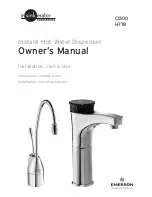
page 7
Figure 1
Figure 2
NORMAL OPERATION
BYPASS OPERATION
“TREATED” WATER
EXITS
SUPPLY WATER
ENTERS
SUPPLY WATER
EXITS
SUPPLY WATER
ENTERS
Figure 3
SUPPLY WATER
EXITS
SUPPLY WATER
ENTERS
DIAGNOSTIC MODE
Figure 4
BYPASS VALVE
The bypass valve is typically used to isolate the control valve from the plumbing system’s water pressure in order to perform control valve
repairs or maintenance. The 1" full flow bypass valve incorporates four positions including a diagnostic position that allows a service
technician to have pressure to test a system while providing untreated bypass water to the building.
The bypass body and rotors are glass filled Noryl and the nuts and caps are glass filled polypropylene. All seals are self-lubricating EPDM
to help prevent valve seizing after long periods of non-use. Internal o-rings can easily be replaced if service is required.
The bypass consists of two interchangeable plug valves that are operated independently by red arrow shaped handles.
The handles identify the direction of flow. The plug valves enable the bypass valve to operate in four positions.
1.
Normal Operation Position: The inlet and outlet handles point in the direction of flow indicated by the engraved arrows on the
control valve. Water flows through the control valve for normal operation of a water softener or filter. During the regeneration
cycle this position provides regeneration water to the unit, while also providing untreated water to the distribution system.
(See Figure 1)
2.
Bypass Position: The inlet and outlet handles point to the center of the bypass.
The system is isolated from the water pressure in the plumbing system.
Untreated water is supplied to the building. (See Figure 2)
3.
Diagnostic Position: The inlet handle points toward the control valve and the outlet handle points to the center of bypass valve.
Untreated supply water is allowed to flow to the system and to the building, while not allowing water to exit from the system to
the building (See Figure 3).
This allows the service technician to draw brine and perform other tests without the test water going to the building.
NOTE: The system must be rinsed before returning the bypass valve to the normal position.
4.
Shut Off Position: The inlet handle points to the center of the bypass valve and the outlet handle points away from the control
valve. The water is shut off to the building.
The water treatment system will depressurize upon opening a tap in the building. A negative pressure in the building combined
with the softener being in regeneration could cause a siphoning of brine into the building.
If water is available on the outlet side of the softener or filter it is an indication of water bypassing the system (i.e. a plumbing
cross-connection somewhere in the building). (See Figure 4)
SHUT OFF MODE
NO WATER
EXITS
SUPPLY WATER IS SHUT OFF
FROM THE HOUSE AND THE VALVE
Содержание FUSION2 F Series
Страница 9: ......









































